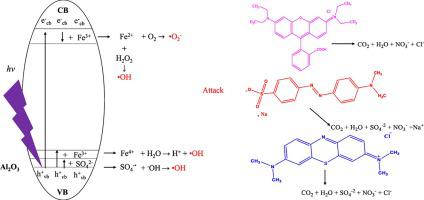Journal of Photochemistry and Photobiology A: Chemistry ( IF 4.1 ) Pub Date : 2021-09-03 , DOI: 10.1016/j.jphotochem.2021.113529 Jesús Tadeo Hernández-Oloño 1 , Antonia Infantes-Molina 2 , Diana Vargas-Hernández 3 , Diana Gabriela Domínguez-Talamantes 1 , Enrique Rodríguez-Castellón 2 , José Ronaldo Herrera-Urbina 4 , Judith Celina Tánori-Córdova 1

|
The activity of heterogeneous photo-Fenton catalysts based on iron and supported on commercial alumina was studied for the degradation of rhodamine B, methyl orange and methylene blue under UV irradiation. The catalysts were prepared by impregnation, drying, and calcination or omitting this last step and referred to as dried or calcined samples. All samples were characterized by X-ray diffraction (XRD), transmission electron microscopy (TEM), N2 adsorption-desorption, diffuse reflectance UV–vis absorption spectroscopy and X-ray photoelectron spectroscopy (XPS). The XRD results revealed that all catalysts showed peaks of α-Al2O3 and FeSO4. The band gap of the catalysts compared with alumina decreased, due to the presences of Fe species which functioned as traps inhibiting the electron-hole recombination. The XPS results revealed the presence hydroxyl groups on the surface and the presence of both Fe3+ and Fe2+ in both catalysts. The photodegradation experiments showed that the heterogeneous photo-Fenton process was much faster compared with the heterogenous photocatalyst on all the tested dyes. The dried Fe/Al2O3 with the presence of H2O2 under UV irradiation showed the best degradation of rhodamine B, methyl orange, and methylene blue at 99.6, 100, and 99.1% at 5, 10, and 5 min, respectively. This could probably be ascribed to a good dispersion of Fe particle species on Al2O3, a low band gap and a proper concentration of hydroxyl groups and sulfate groups on the surface. The scavenger test revealed that the hydroxyl radicals played the main role in the photodegradation of dyes in this process compared with the superoxide radicals and positive holes.
中文翻译:

一种用于染料降解的新型多相光芬顿 Fe/Al2O3 催化剂
研究了基于铁并负载在商业氧化铝上的多相光芬顿催化剂在紫外线照射下降解罗丹明 B、甲基橙和亚甲蓝的活性。催化剂通过浸渍、干燥和煅烧或省略这最后一步制备,称为干燥或煅烧样品。所有样品均通过 X 射线衍射 (XRD)、透射电子显微镜 (TEM)、N 2吸附-解吸、漫反射紫外-可见吸收光谱和 X 射线光电子能谱 (XPS) 进行表征。XRD结果表明,所有催化剂均显示出α-Al 2 O 3和FeSO 4峰. 与氧化铝相比,催化剂的带隙减小,这是由于 Fe 物种的存在,其充当了抑制电子-空穴复合的陷阱。XPS 结果表明在两种催化剂中都存在表面羟基和 Fe 3+和 Fe 2+。光降解实验表明,在所有测试染料上,与非均相光催化剂相比,非均相光芬顿过程要快得多。在H 2 O 2存在下干燥的 Fe/Al 2 O 3在紫外线照射下,罗丹明 B、甲基橙和亚甲蓝在 5、10 和 5 分钟时的降解率分别为 99.6、100 和 99.1%。这可能归因于 Fe 颗粒物质在 Al 2 O 3上的良好分散、低带隙以及表面羟基和硫酸根的适当浓度。清除剂试验表明,与超氧自由基和空穴相比,羟基自由基在该过程中对染料的光降解起主要作用。











































 京公网安备 11010802027423号
京公网安备 11010802027423号